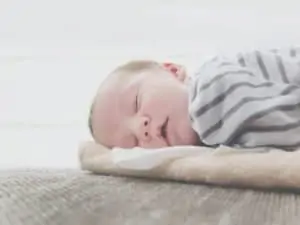Even though your baby is two months old, he is still considered a newborn. However, now that he is getting older, there are some considerable differences in his two-month-old baby’s sleep schedule compared to the previous weeks.
Now that your baby is getting older, chances are you’re noticing that he stays awake a bit more throughout the day. His little personality shines through sometimes as he starts to smile more at you. It’s a wonderful time to be a parent, watching your baby grow and change each day.
At two months old, his sleep is still a bit irregular, but during this time, sleep starts to organize itself. Your baby might begin to sleep longer stretches at night, have long stretches of awake time throughout the day, and you’ll see some sort of routine develop.
Let’s learn what you should expect from your two-month-old baby’s sleep schedule.
How Much Should My Two-Month-Old Sleep Each Day?
Most two-month-old babies sleep 9 to 12 hours at night and four to six hours throughout the day. Those daytime hours will be broken into several naps.
Naptimes are still a bit erratic at this time. As your baby gets older and matures, you’ll notice his naps consolidate together and become three naps at set times by five or six months old. You’re not there just yet. Instead, your baby sleeps when he is tired, and that’s perfectly acceptable at this stage.
Something else that you should know about your baby’s sleep right now is that bedtimes aren’t early at this stage. You might have heard about your friends putting their kids to bed early – my two year old goes to bed at 7 PM – but you haven’t reached this stage yet. Since they aren’t sleeping 11 to 12 hours at night right now, bedtimes are still later, typically between 9:30 PM and 11 PM.
How Often Will My Two Month Old Eat?
Something that hasn’t changed too much is how often your baby will eat. Most 2-month-olds eat several times throughout the night. Depending on whether you’re breastfeeding or formula feeding, you can expect your baby to eat every two to three hours.
At this age,
Some babies start to consolidate feedings, especially formula-fed babies. Your baby’s stomach capacity is larger, so some babies can handle longer stretches between feedings.
For breastfed babies, this isn’t always true. Breastmilk digests faster, so many breastfed babies want to continue to breastfeed every two to three hours throughout the day and continue night feedings. That’s okay, though, because it does help to maintain your milk supply where you need it to be.
Don’t be tempted to introduce solid foods at this age in an attempt to improve sleep. Babies at two months old are still too young to handle solid foods, and there is no evidence that the introduction of solid foods enhances the amount of sleep your baby has at night.
Expect Your 8-Week-Old to Be Cranky

I want to give you guys a huge hint – use the Wonder Weeks app on your smartphone. They also have a book available, and they show you when to expect your baby to hit a developmental week called leaps.
For all of my babies and my friends who use this, it’s spot on, and it can give you some clarity when your usually happy baby suddenly turns into a cranky, crying monster.
Mental leap two starts around eight weeks old, and it’s when your baby starts to recognize patterns in the world. You might find your baby staring at the ceiling fan for 20 minutes, or he might stare at the shadows on the wall.
Durn this time, your baby might be more clingy and cranky. It doesn’t last forever, and it can affect his sleep patterns. This leap ends around ten weeks old.
How to Help Your Baby Sleep Better
As you move out of the newborn baby sleep phase, you can start to incorporate different practices and routines to help your baby sleep better. It’s hard to introduce some of these ideas when your baby is just a few weeks old, and everything is a blur of feeding, poopy diapers, and waking up at all hours of the night.
Here are some ideas. 😀
Incorporate a Bedtime Routine
If you didn’t start a bedtime routine before, now is an excellent time to start. Using a simple routine helps your baby establish the difference between day time and night time. It also helps your baby understand, as he gets older, that bedtime approaches.
This is important:
Some parents have complex routines, but I recommend simplicity. I also don’t recommend that you include bathtime in that routine because many babies are unable to take daily baths due to sensitive or dry skin issues. You need to be able to replicate the routine even on busy evenings.
The routine can be as simple as:
- Application of lotion and a quick baby massage
- Putting on new pajamas with a fresh diaper
- Reading a book together
- Feeding time
- Bedtime
Simple but effective matters the most here. Don’t forget; you’re also going to turn down the lights throughout the house and make it quieter.
Keep Swaddling If Not Rolling
Doctors all have different opinions on when to stop swaddling. Some recommend that you stop swaddling at eight weeks old, while others tell you that there is no need to stop swaddling until your baby starts to roll.
Talk to your doctor about what is the best decision for your baby and what makes you most comfortable. Swaddling is a great technique to get your baby more sleep and yourself as well!
Use a Transition Sleep Sack
At two months old, so babies start to fight the swaddle, or they might begin to roll, so you have to stop swaddling. That can be hard if your baby likes swaddling to sleep. If you find yourself in that position, try a sleep sack or a swaddle designed for transitional times. These allow your baby to use their arms while still providing that snug, comfortable feel associated with the swaddle.
Try White Noise
If you haven’t incorporated white noise into your sleep routine, I highly encourage you to do so now. White noise can help your baby drift off into a deep slumber and stay there. All you need is a white noise machine. It’s incredible how much better babies sleep!
Put Your Baby Down Drowsy Awake
This is optional, and not all parents want to try this. That’s okay! Remember, this is your baby.
For some parents, around this age, they start trying to encourage their baby to put themselves to sleep by laying their baby down drowsy but still awake. Doing so can help your baby learn to put himself to sleep.
It’s important to note that, at this age, there is no reason to let your baby cry to sleep. If you find that putting your baby down drowsy results in a loss of sleep and too many tears, don’t stress. Give your baby the time to try, but it’s no big deal if it doesn’t work.
Some parents might argue that this is a big deal, but as a mother of four kids, I’ve never laid my babies down tired and let them fall asleep. For an update, we all sleep peacefully now, so it’s not something that will make or break your baby’s sleep.
If you do want to give this a try, the first nap of the day and bedtime are the best times to try it because it’s when your baby has the strongest desire for sleep.
A Two-Month-Old Sleep Schedule
It’s hard to put your baby on a schedule at this age, but babies generally fall into routines around this age. You’ll start to notice what your baby does naturally, and you can use this to plan a loose schedule.
Most babies aren’t ready for any strict schedule until closer to six months old. Some babies are ready sooner, but a two-month-old is not prepared for strictness.
Something you can do at this age is to use fixed points to establish some sort of schedule. We did this with our babies, and it seems to work well. A fixed point is a time that you start your baby’s morning; it’s wake-up time. It works well for all ages.
You’ll see on our sample schedules that a consistent wake-up time, and this works towards creating consistency throughout the rest of the day. It’s impossible to have a generalized, regular routine if one day, your baby wakes up at 7 AM for the day and the next day at 9:30 AM.
Pick a fixed wake-up time as well as a set bedtime for your baby at this stage. You don’t have to use the times on these example schedules; figure out what works best for your baby.
Sample of a Formula-Fed Two Month Old Baby Sleep Schedule
| Wake and Feed | 8:00 AM |
| Nap Time | 9:30 AM |
| Wake and Feed | 11:00 AM |
| Nap | 12:30 PM |
| Wake and Feed | 2:00 PM |
| Nap Time | 3:30 PM |
| Wake Up | 4:30 PM |
| Feed | 5:00 PM |
| Catnap | 5:30 PM |
| Wake | 6:00 PM |
| Feed | 7:00 PM |
| Catnap | 7:30 PM |
| Catnap | 9:30 PM |
| Feed and Bedtime | 11:00 PM |
| 2-3 Nighttime Feedings |
Sample of a Breast-Fed Two Month Old Baby Sleep Schedule
| Wake-up Time | 8:00 AM |
| Feeding | 8:00 AM |
| Nap Time | 9:30 AM |
| Wake-Up and Feed | 10:00 AM |
| Feed and Nap Time | 12:00 PM |
| Wake and Feed | 2:00 PM |
| Nap | 3:00 PM |
| Wake and Feed | 4:00 PM |
| Feed and Nap | 6:00 PM |
| Catnap | 7:30 PM |
| Feed | 8:00 PM |
| Catnap | 9:00 PM |
| Feed | 10:00 PM |
| Feed and Bedtime | 11:00 PM |
| 3-4 Nighttime Feedings |
What About the Eat-Play-Sleep Schedule?
At this age, some people recommend that you use a loose itinerary called Eat-Play-Sleep.
With this schedule, your baby wakes up from his nap, and it’s time to breastfeed your baby or give your baby a bottle. After eating, your baby can do tummy time, lay on his play mat on the floor, or you could play with your baby. Your baby can hang out in the vibrating seat, or you can play patty cake.
Whatever works and encourages the play part of his life.
Then, it’s time to go to sleep. At this age, it’ll be soon after feeding (which can take some time) and playing. You have to watch for signs of tiredness and put your baby to bed as soon as you see those signs. ?
If you want to implement this schedule, feel free to do so. One reason that parents don’t do so at this age is that your baby’s awake time for play is so small. It becomes more comfortable to use this schedule as your baby reaches the 3 or 4 month age when they stay awake longer.
Changes Are Coming
On the horizon are some significant changes. As your baby enters his third and fourth month of life, his sleep cycles drastically change, and the dreaded four-month sleep regression is on its way. Keep working on healthy sleep habits and getting as much sleep as possible to avoid an overtired, cranky baby.
Hey, this is Linda. My biggest accomplishment in life is being a mother of four children. Their current ages range from almost ten years old down to 20 months old.
I’m passionate about writing parenting articles because I understand so well all of the problems and trials you face as a parent. From breastfeeding woes to budgeting problems and behavior problems, along with everything in between, chances are I’ve faced it over the last ten years. Read more about Linda here.






